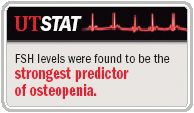Article
Infertile men could be at risk for osteopenia
While it does not affect the vast majority of male infertility patients, a subgroup of men with disrupted hormonal axes and/or hypogonadism should be worked up for the presence of osteopenia.

Key Points

In what appears to be the first study of its kind involving infertile patients, investigators found that the incidence of osteopenia among infertile men is 9%. Significantly, that figure rises to 21% in severely oligospermic men.
The 46 patients in the study ranged in age from 18 to 60 years, but the majority were in their 30s and 40s. In that age range among the general population, one would expect to see an incidence of osteopenia of only about 5%, said Daniel Kaplon, MD, who presented the study at the AUA annual meeting here.
"There's an important group of patients we're teasing out here who are going to be evaluated for infertility and found to have some degree of hypogonadism causing their infertility. It's those patients who should be worked up and suspected to have osteopenia, even at young ages."
Men presenting for infertility evaluation were offered bone mineral density readings using an accuDEXA scanner (Schick Technologies, Long Island City, NY). Researchers also performed semen analysis and collected data on total testosterone, follicle-stimulating hormone (FSH) levels, testicular volume, and body mass index. Using linear regression analysis, they correlated those findings with BMD.
Four of the 46 patients (9%) presented with BMD scores indicative of osteopenia. The prevalence of the condition in men with sperm counts <5 million was 21%, compared with 3% for those with higher counts. Mean BMD differed significantly between the two sperm count groups (p=.035).
"Most of the time, the severely oligospermic or azoospermic patients have some underlying hormonal deficiency, such as impaired spermatogenesis from hypogonadism, and we know that that contributes to osteopenia and osteoporosis," Dr. Kaplon explained.
Total sperm count correlated positively with BMD (p=.01) and average testicular volume (p=.031), and negatively with FSH (p=.003). Age, BMI, and total testosterone did not correlate significantly with BMD. Further analysis showed that total testosterone, total sperm count, and FSH did not differ significantly between groups with high, normal, and low BMD readings.
FSH strongest predictor
Given that, Drs. Kaplon and Sigman developed a statistical model to determine which factors were most indicative of osteopenia. They found that FSH levels were the strongest predictor, suggesting that men with elevated levels are at risk for osteopenia and should be evaluated for it.
"We use FSH as a marker for impaired testicular function, and elevated FSH in the case of infertility usually implies some failure of spermatogenesis," Dr. Kaplon said. "So if FSH levels are elevated in a young male, that suggests something is going on at the level of the testicles that's causing impaired spermatogenesis, and these patients may be at risk for osteopenia."
Still, Dr. Kaplon noted, while the accu-DEXA is relatively inexpensive to use, it would not be cost effective to work up all male infertility patients for osteopenia, given the fact that even mild cases won't require treatment.
Dr. Kaplon's literature search found no other published examination of BMD levels and osteopenia in infertile men. However, the Brown study was inspired by a wealth of similar investigations involving prostate cancer patients, who often undergo intentional hormonal blockade and are thus at risk for osteopenia or osteoporosis.
Newsletter
Stay current with the latest urology news and practice-changing insights — sign up now for the essential updates every urologist needs.
















